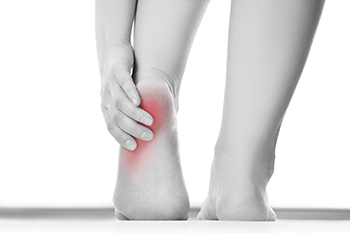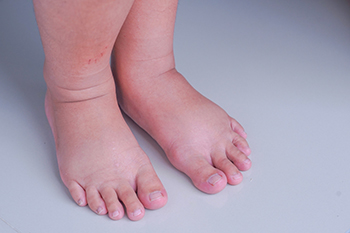
The muscles in the feet can become overworked. This may result in foot pain, and it can happen from repetitive body movement. Foot pain may also occur from wearing shoes that do not fit correctly or standing on hard or uneven surfaces for most of the day. People who are overweight may also experience foot pain from the extra weight the feet must endure. Additionally, existing foot conditions such as flat feet, bunions, or hammertoe may cause foot pain, and many patients seek relief from a podiatrist. It is beneficial to wear shoes that are made with quality materials, in addition to having good arch support and shock absorbers. Many people enjoy having regular foot massages performed to help reduce aches and foot pain. If you have foot pain for any reason, it is strongly suggested you are under the care of a podiatrist who can diagnose the cause and offer treatment solutions that are right for you.
Foot Pain
Foot pain can be extremely painful and debilitating. If you have a foot pain, consult with one of our podiatrists from Jill Einhorn, DPM and James Einhorn, DPM. Our doctors will assess your condition and provide you with quality foot and ankle treatment.
Causes
Foot pain is a very broad condition that could be caused by one or more ailments. The most common include:
Diagnosis
To figure out the cause of foot pain, podiatrists utilize several different methods. This can range from simple visual inspections and sensation tests to X-rays and MRI scans. Prior medical history, family medical history, and any recent physical traumatic events will all be taken into consideration for a proper diagnosis.
Treatment
Treatment depends upon the cause of the foot pain. Whether it is resting, staying off the foot, or having surgery; podiatrists have a number of treatment options available for foot pain.
If you have any questions, please feel free to contact our offices located in Brooklyn and Astoria, NY . We offer the newest diagnostic and treatment technologies for all your foot care needs.

Sever’s disease affects the heel. It can happen in children and young teenagers who frequently participate in running and jumping activities. Parents may notice their child is limping or walking on tiptoes, which are common symptoms of Sever’s disease. This condition can happen as a result of repetitive stress to the heel bone growth area. As the heel grows, the consistent activity may cause the growth plate to heal improperly, possibly causing Sever's disease. The growth plate can be protected by wearing shoes that fit well while engaging in these types of activities. Having good arch support and cushioning may help the heel to recover in a timely manner. Treatment generally begins with temporarily stopping the activity that caused this condition, and it may help to elevate the affected foot as often as possible. If your child has symptoms of Sever’s disease, it is strongly suggested that a podiatrist is consulted as quickly as possible who can provide permanent treatment solutions.
Sever's disease often occurs in children and teens. If your child is experiencing foot or ankle pain, see one of our podiatrists from Jill Einhorn, DPM and James Einhorn, DPM. Our doctors can treat your child’s foot and ankle needs.
Sever’s Disease
Sever’s disease is also known as calcaneal apophysitis, which is a medical condition that causes heel pain I none or both feet. The disease is known to affect children between the ages of 8 and 14.
Sever’s disease occurs when part of the child’s heel known as the growth plate (calcaneal epiphysis) is attached to the Achilles tendon. This area can suffer injury when the muscles and tendons of the growing foot do not keep pace with bone growth. Therefore, the constant pain which one experiences at the back of the heel will make the child unable to put any weight on the heel. The child is then forced to walk on their toes.
Symptoms
Acute pain – Pain associated with Sever’s disease is usually felt in the heel when the child engages in physical activity such as walking, jumping and or running.
Highly active – Children who are very active are among the most susceptible in experiencing Sever’s disease, because of the stress and tension placed on their feet.
If you have any questions, please feel free to contact our offices located in Brooklyn and Astoria, NY . We offer the newest diagnostic and treatment technologies for all your foot and ankle injuries.

A broken toe can easily happen as a result of being located at the end of the body. Broken toes may occur if a heavy object drops on them, or if the toe is stubbed into a piece of furniture. Broken or fractured toes are easy to notice because swelling and bruising occurs immediately. It is a painful injury and an X-ray is often taken which can determine the severity of the fracture. Additional symptoms can include a popping sound at the time of injury and it is often difficult to walk. A mild break can be treated by using the buddy taping method, which is done by taping the affected toe to the toe next to it. Buddy taping is often successful in providing the necessary stability as the healing process takes place. For severely broken toes, surgery may be necessary to replace any protruding bones in addition to realigning the toes to their normal position. If you have broken your toe, it is suggested that you speak with a podiatrist who can help you with the treatment that is best for you.
A broken toe can be very painful and lead to complications if not properly fixed. If you have any concerns about your feet, contact one of our podiatrists from Jill Einhorn, DPM and James Einhorn, DPM. Our doctors will treat your foot and ankle needs.
What to Know About a Broken Toe
Although most people try to avoid foot trauma such as banging, stubbing, or dropping heavy objects on their feet, the unfortunate fact is that it is a common occurrence. Given the fact that toes are positioned in front of the feet, they typically sustain the brunt of such trauma. When trauma occurs to a toe, the result can be a painful break (fracture).
Symptoms of a Broken Toe
Generally, it is best to stay off of the injured toe with the affected foot elevated.
Severe toe fractures may be treated with a splint, cast, and in some cases, minor surgery. Due to its position and the pressure it endures with daily activity, future complications can occur if the big toe is not properly treated.
If you have any questions please feel free to contact our offices located in Brooklyn and Astoria, NY . We offer the newest diagnostic and treatment technologies for all your foot and ankle needs.

There are various reasons why people may experience swollen feet. Having high blood pressure is a common reason that feet can swell, and limiting salt intake and drinking plenty of water may help to reduce this. Research has shown that many women who are premenopausal develop swollen feet, possibly as a result of their body preparing to start the next phase of their life. Existing medical conditions may lead to having swollen feet, including diabetes, poor circulation, or heart disease. Integrating a gentle exercise and stretching routine may help to control swollen feet, in addition to losing extra weight, if applicable. People who stand for long periods of time during their work day may have swollen feet, and it can be helpful to wear shoes that fit correctly. The arthritic condition that is known as gout may cause the feet to swell, and relief may be found when eating habits are changed. If you have swollen feet, it is suggested that you consult with a podiatrist who can determine the cause and offer you correct treatment solutions.
Swollen feet can be a sign of an underlying condition. If you have any concerns, contact one of our podiatrists of Jill Einhorn, DPM and James Einhorn, DPM. Our doctors can provide the care you need to keep you pain-free and on your feet.
Swollen feet are a common ailment among pregnant women and people who stand or sit for extended periods. Aging may increase the possibility of swollen feet and patients who are obese often notice when their feet are swelling too. There may be medical reasons why swollen feet occur:
Swollen feet can also be caused by bone and tendon conditions, including fractures, arthritis, and tendinitis. Additionally, there may be skin and toenail conditions and an infection may cause the feet to swell. Patients who take medicine to treat high blood pressure may be prone to getting swollen feet.
Many patients elevate their feet to help relieve the swelling and this is generally a temporary remedy. When a podiatrist is consulted the reason behind the swelling can be uncovered and subsequently treated.
If you have any questions please feel free to contact our offices located in Brooklyn and Astoria, NY . We offer the newest diagnostic tools and technology to treat your foot and ankle needs.

Gout is a particular kind of foot condition that can be quite an annoyance for patients. Gout develops when urate crystals accumulate in joints of the feet. As a result of this accumulation, inflammation and pain can ensue. Podiatrists often use the term “gout attack” when talking with gout patients. This term refers to periods of time in which these crystals accumulate and pain is felt. An attack can be triggered by many different things. A common reason for a gout attack, among others, is eating foods that are high in purines. If you are someone that is living with gout, it is highly recommended that you consult a podiatrist today for assistance.
Gout is a foot condition that requires certain treatment and care. If you are seeking treatment, contact one of our podiatrists from Jill Einhorn, DPM and James Einhorn, DPM. Our doctors will treat your foot and ankle needs.
What Is Gout?
Gout is a type of arthritis caused by a buildup of uric acid in the bloodstream. It often develops in the foot, especially the big toe area, although it can manifest in other parts of the body as well. Gout can make walking and standing very painful and is especially common in diabetics and the obese.
People typically get gout because of a poor diet. Genetic predisposition is also a factor. The children of parents who have had gout frequently have a chance of developing it themselves.
Gout can easily be identified by redness and inflammation of the big toe and the surrounding areas of the foot. Other symptoms include extreme fatigue, joint pain, and running high fevers. Sometimes corticosteroid drugs can be prescribed to treat gout, but the best way to combat this disease is to get more exercise and eat a better diet.
If you have any questions please feel free to contact our offices located in Brooklyn and Astoria, NY . We offer the newest diagnostic and treatment technologies for all your foot and ankle needs.